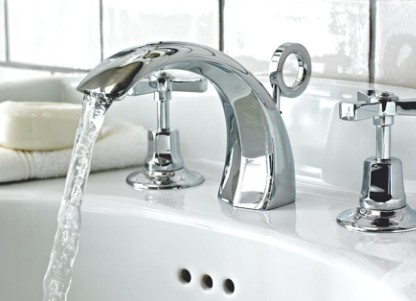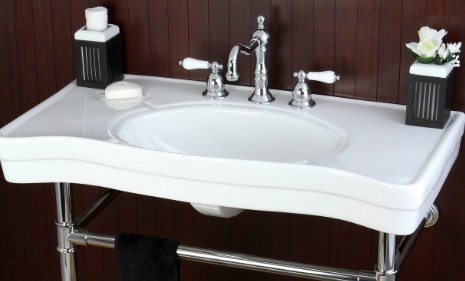Have you ever wondered how inconvenient and disruptive if you turn on your faucets only to find out there’s no water in bathroom sink but everywhere else?
The warm water from your bathroom sink helps you wash your hands, clean items like makeup brushes, and even your face more effectively than cold water.
You don’t have hot water in your bathroom sink because of a clogged aerator, clogged pipes, a malfunctioning hot water valve, and water heater issues. Other causes are frozen pipes, airlock problems, and cartridge issues.
You must address this problem if you wish to get water from your bathroom sink again. So, learn how to do so below.

No Hot Water In Bathroom Sink But Everywhere Else Fixed! (Causes & Fixes!)
| Problem | Possible Causes | Recommended Fixes | |
| 1. | Clogged Aerator | Debris and mineral deposits | Clean the aerator |
| 2. | Clogged Pipes | Mineral deposits and debris accumulation | Increase the water pressure Clear clogs |
| 3. | Malfunctioning Hot Water Valve | Debris accumulation Wear and tear | Clean the hot water valve or replace it |
| 4. | Water Heater Issues | Sediment buildup Leaks Electrical issues Gas supply issues Wear and tear Incorrect installation and maintenance | Flush the water heater to clean it Fix leaks Relight the pilot light Adjust the thermostat temperature Install a new water heater |
| 5. | Frozen Pipes | Winter weather | Warm frozen pipes using a hair dryer, heating pad, or heat gun |
| 6. | Airlock Problems | Water pressure changes Repairs and maintenance Air accumulation | Move the airlock |
| 7. | Cartridge Issues | Debris Wear and tear | Clean the cartridge Install a new cartridge |
1. Clogged Aerator
An aerator is a tiny device screwed onto a faucet’s end that mixes air with flowing water. This device reduces the water’s flow rate while maintaining or improving the perceived water pressure, helping conserve water.
However, it must be in great condition because a faulty aerator causes problems. For instance, if debris and mineral deposits accumulate inside the aerator, it restricts water flow, slowing it down or stopping it entirely.
A clogged aerator can specifically impact the hot water flow since the hot water usually carries more minerals than cold water. This can cause hot water to flow slower or not at all, while cold water may still flow without issue.
Fix
Remove the aerator from your bathroom faucet and clean it to remove debris or mineral buildup. Cleaning the aerator is pretty simple.
- Stop the water flow.
- Turn the aerator counterclockwise with your hand, cloth, or pliers to unscrew it.
- Carefully disassemble the aerator, ensuring you take note of the installation order.
- Rinse each component under running water to remove dirt or debris, then scrub stubborn buildup with a small brush or toothbrush.
- Soak the components in vinegar for 30 to 60 minutes to dissolve heavily coated minerals, then rinse them under running water.
- Reassemble the aerator in the correct order, then screw it back.
- Restore the flow of water, then test the hot water.
2. Clogged Pipes
If hot water flows out of your showerhead, kitchen sink, tub faucets, and other parts that dispense hot water apart from your bathroom sink, it could mean a specific water line is clogged. The obstruction could be caused by mineral buildup, debris, and other substances stuck inside the pipe.
This issue becomes severe if coupled with other problems like low water pressure.
Fix
- Increase the water pressure to help restore water flow.
- Detach the faucet, then clean it with a long brush, water, and vinegar.
- Unclog the blocked pipe.
3. Malfunctioning Hot Water Valve
Water must pass through the faucet valve before flowing out. This component controls water flow by opening and closing the passageway to allow and stop water flow, respectively.
However, your faucet may stop functioning correctly if the water valve is damaged or stuck. For instance, if your bathroom sink’s hot water valve malfunctions, it can prevent the flow of hot water.
On the one hand, hot water will not flow from your bathroom sink if the hot water valve gets stuck in the closed position. On the other hand, you may find hot water running even with the faucet turned off if the valve is stuck in the open position.
Fix
- Valve malfunction can happen due to debris or mineral buildup. If that’s the case, remove the valve from your bathroom sink faucet, then soak it in vinegar for 1 to 2 hours. After that, rinse thoroughly with water, then reinstall it.
- Replace the hot water valve if cleaning it does not resolve the problem.
4. Water Heater Issues
The hot water flowing from your faucets, showers, dishwashers, washing machines, and tubs comes from the water heater, which is a home appliance designed to heat and store water. A water heater is usually kept in the basement, utility room, or garage and connected to your plumbing system.
You won’t have an issue accessing hot water if your heater works superbly. However, if it malfunctions, it may fail to produce sufficient hot water to reach your bathroom sink.
A water heater can malfunction due to these reasons:
a) Sediment Buildup
A water heater’s efficiency can diminish if sediments accumulate at the bottom, causing it to overheat, thus damaging the tank and other components.
b) Leaks
Damage to the pipes, pressure relief valve faults, tank damage, and other faults can make your water heater leak. This causes water damage and safety hazards and prevents hot water from reaching the bathroom.
c) Wear and Tear
Although water heaters last for 10 to 15 years, they eventually give in to age, causing them to lose their efficiency and making them more susceptible to issues. So, your water heater may be worn out if you start experiencing a hot water shortage.
d) Electrical Issues
If your water heater runs on electricity, electrical problems can keep it from functioning correctly. These issues include thermostats, heating elements, or wiring problems.
e) Gas Supply Issues
Gas supply issues like gas valves, pilot light, or thermocouple problems can also cause your water heater to malfunction if you have a gas water heater.
f) Improper Installation Or Maintenance
You must install your water heater correctly and maintain it well to work properly and for a long time. It would be best to have a professional install and maintain it.
Fix
- Flush the water tank heater to remove sediments.
- Reset the circuit breaker or fit in a new fuse.
- Relight the pilot light (if applicable).
- Check the heating element and adjust the thermostat temperature to the appropriate level.
- If your water heater is gas-based, ensure the valve is fully open.
- Install a new water heater.

5. Frozen Pipes
Water will not flow through frozen pipes successfully, so if your bathroom sink pipe freezes, you won’t have hot water. However, this should not be an issue unless you live in areas that experience winter.
Fix
Insulate your pipes before winter to get ahead of this problem. However, should it occur, here’s how to warm your frozen pipes.
- Stop water flow to prevent additional water from entering the frozen pipes and causing more damage.
- Turn on your bathroom sink faucet to allow water to flow after thawing the pipes.
- Slowly thaw the frozen pipes by pointing a space heater or hair dryer at them. However, be sure to keep the heater or dryer a safe distance away from flammable materials. You can speed up the thawing process by wrapping the frozen pipes with heat tape or towels soaked in hot water.
6. Airlock Problems
An airlock refers to a phenomenon that occurs when air gets trapped in a plumbing system, preventing the water from flowing correctly. It can cause various issues, such as low water pressure, no water flow, or noisy pipes.
Airlocks can affect both hot and cold water systems. However, hot water sides are less likely to be affected because cold water is typically connected directly from the primary water line; hence it usually has more pressure.
Airlocks are more common in vertical pipes, such as those found in tall buildings or multi-story homes, where air can get trapped more easily. This phenomenon is often caused by water pressure changes, repairs and maintenance, and air accumulation, among other reasons.
Fixes
- Attach one end of a hosepipe to your bathroom’s hot water faucet and the other to the cold water faucet, then secure the connection using a clamp.
- Open the hot water followed by the cold water. The cold water line should release sufficient pressure to release the airlock.
- Keep the cold water running for around 30 seconds.
- Reapply the procedure multiple times for maximum effect.

7. Cartridge Issues
The cartridge regulates the hot and cold water flow as well as the temperature. However, if the cartridge becomes worn and damaged, it can cause problems, including not having hot water in your bathroom sink.
You are more likely to encounter cartridge issues with a single-action faucet. Over time, dirt or debris accumulation can obstruct the water pathway, with this problem affecting the hot water line more because of its lowered pressure.
Fix
- Take out the cartridge, dip it in vinegar, and allow it to soak for around 24 hours to remove debris.
- Also, inspect it for damage or wear signs like breaks or cracks in the rubber or plastic components. Replace the cartridge if worn out.
Final Remarks On No Hot Water In Bathroom Sink But Everywhere Else
You can use hot water from other areas of your home, such as the shower and kitchen sink if the hot side of your bathroom sink malfunctions. However, it’s best to fix the issue for your comfort and convenience. The above guide will help you address this problem.
Also, read:
